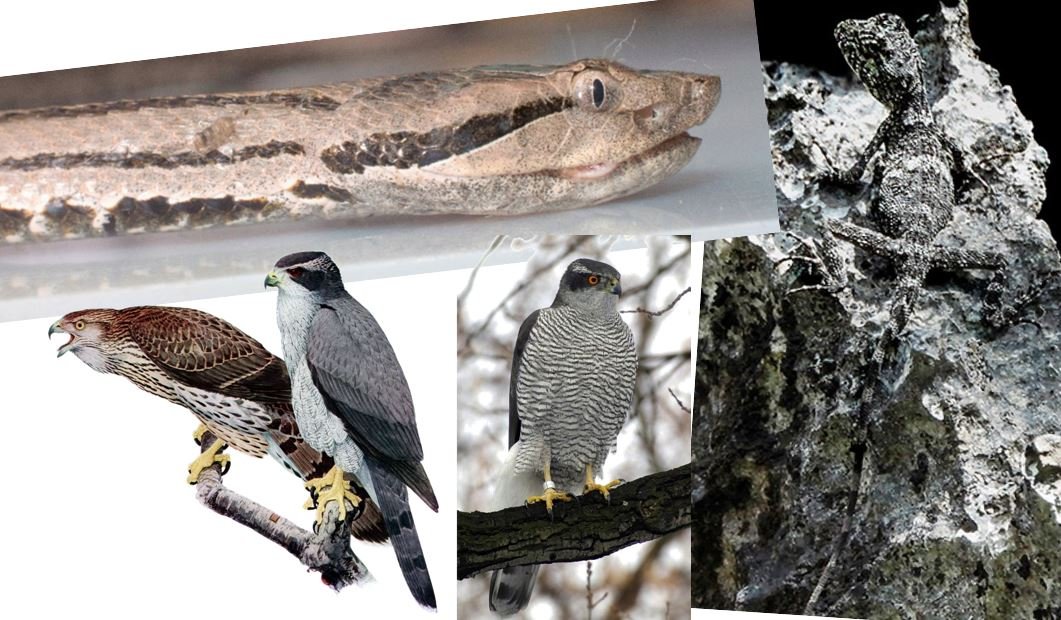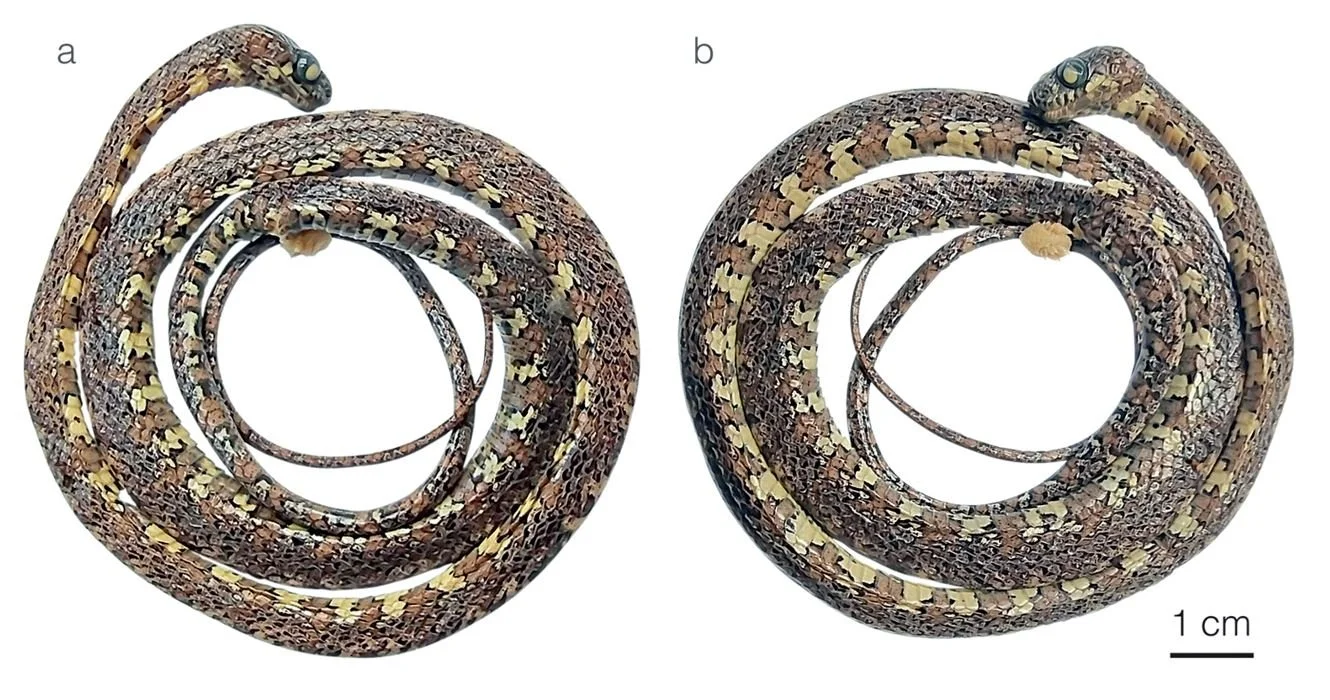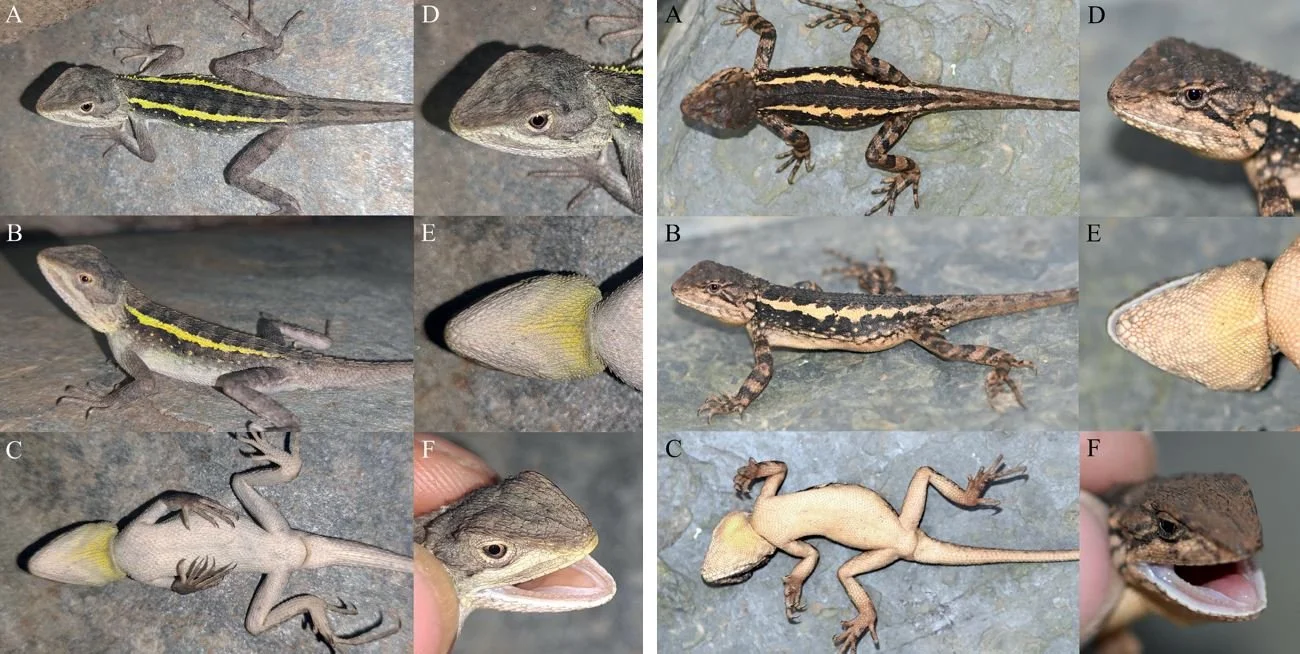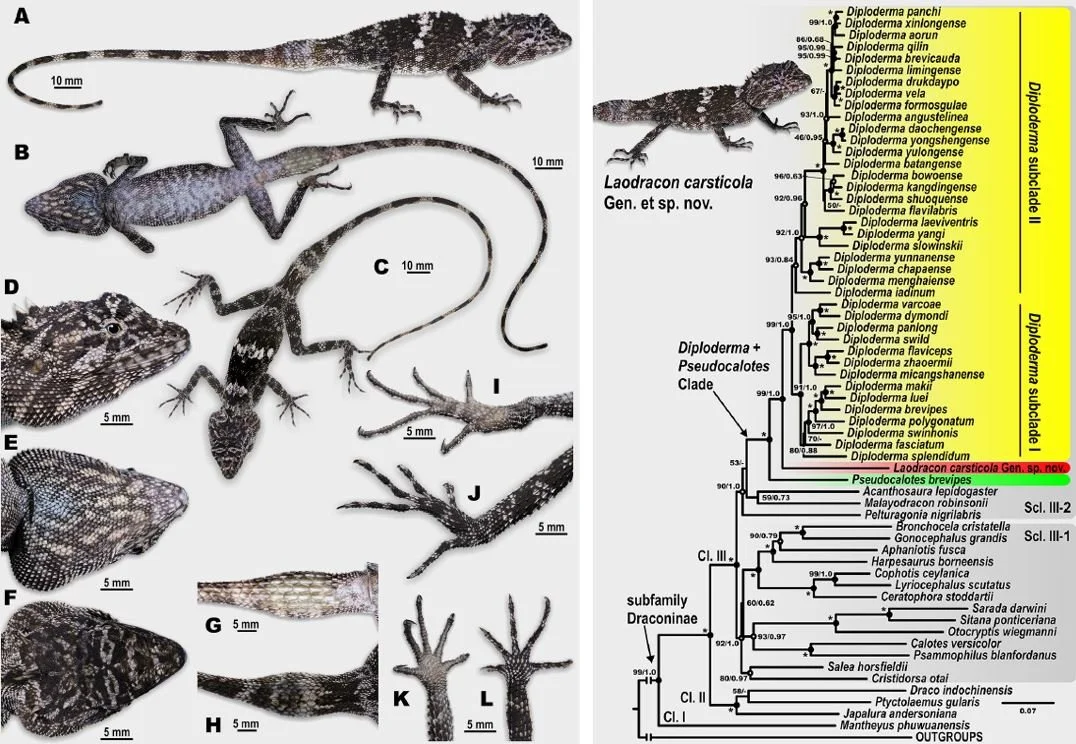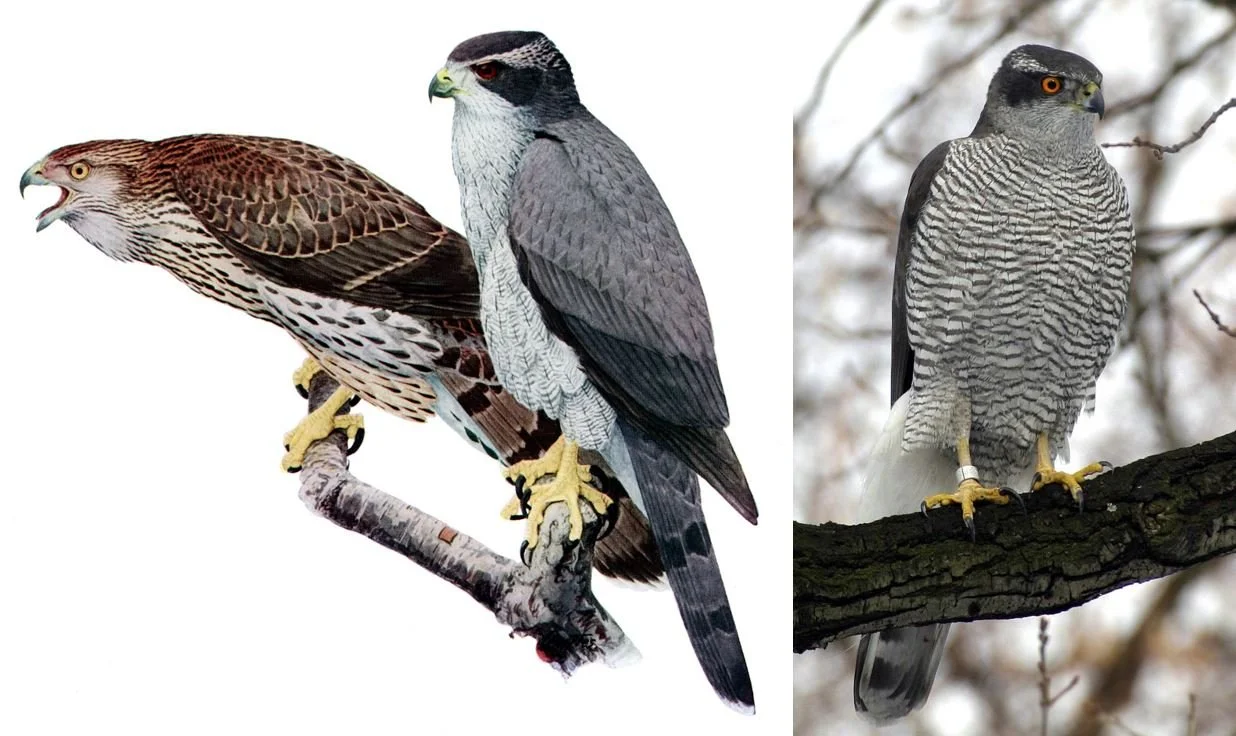In the previous article we looked briefly at those new amphibian and mammal species named during 2023. This time we skip ahead to reptiles… including birds because – yes – birds are reptiles in the phylogenetic sense….
Caption: a ‘new’ species montage for 2023…. err, sorta. Clockwise from upper left: Chamba pitviper Gloydius chambensis Kuttalam et al., 2023, Khammouan karst dragon Laodracon carsticola Brakels, Sitthivong, Wang, Nguyen & Poyarkov, 2023 in karst habitat, goshawk montage (see below). Images: Kuttalam et al. (2023); Sitthivong et al. (2023); Louis Agassiz Fuertes, in public domain; at right, Norbert Kenntner, CC BY-SA 3.0 (original here).
Some snakes and some lizards. Yeah yeah, snakes are lizards, but you know what I mean. One thing is clear when you look at new squamate species named in any one year, and that’s geckos geckos geckos. 2023’s list includes new species of Paroedura from Madagascar, at least seven new Lygodactylus dwarf geckos, several new Australian Amalosia geckos, and at least three new bent-toed geckos (Cyrtodactylus). A revision that saw much shuffling of the geckos formerly included in Ptychozoon saw print (some are now included within Gekko), this occurring hand-in-hand with the naming of some new Gekko species (Lalremsanga et al. 2023). That’s a sufficiently complex issue that I’ll have to put it to one side for now. New anoles, chameleons, lacertids, teiids and more also saw print.
Caption: Mizoram parachute gecko Gekko mizoramensis Lalremsanga et al., 2023. There was a time when geckos of this sort were classified together in Ptychozoon, but at least some are now included within Gekko. Image: (c) Lal Muansanga.
New snakes for 2023 include Harrison Ford’s slender snake Tachymenoides harrisonfordi Lehr et al., 2023, a dipsadine colubroid from Peru and only the second species of its genus to be named. That genus was itself only recognised in 2022, having been previously included within Tachymenis. Yes, it’s named after Harrison Ford and is one of several species that honour him (the others are all arthropods, I think); the authors note that this is “in recognition of his work for Conservation International and his voice for nature” (Lehr et al. 2023, p. 203).
A study of dipsadines from Colombia, Ecuador and Panama resulted in the recognition of four new Sibon species and one new Dipsas, and one of these made the newswires: DiCaprio’s snail-eating snake Sibon irmelindicaprioae Arteaga & Batista, 2023, a Near Threatened species from Panama. It’s named in honour of “Irmelin DiCaprio (1945–present), mother of Leonardo DiCaprio, long-time advocate and supporter of biodiversity conservation around the world” (Arteaga & Batista 2023). Ah, eponyms… hold that thought.
Caption: holotype specimen of DiCaprio’s snail-eating snake Sibon irmelindicaprioae Arteaga & Batista, 2023. It’s an adult male, collected at Cerro Bailarín, Panama, in 2011. Image: Arteaga & Batista (2023).
Caption: at left, images of the holotype of Harrison Ford’s slender snake Tachymenoides harrisonfordi Lehr et al., 2023 in life. The red arrows point to the three longitudinal skin folds present in this species. The snake is 40 cm long. At right, the holotype (when alive) of the Chamba pitviper Gloydius chambensis Kuttalam et al., 2023. It’s 42.6 cm long. Images: Lehr et al. (2023), Kuttalam et al. (2023).
Four new species of the odd-scaled xenodermid genus Achalinus, all from China, were named during the year, as was the karst-dwelling pitviper Trimeresurus ciliaris Idiiatullina et al., 2023 from Thailand and the Chamba pitviper Gloydius chambensis Kuttalam et al., 2023 from India.
Caption: a montage featuring new (for 2023) species of the Asian draconine agamid Diploderma. At left, the Diploderma jiulongense holotype, from Yandai, Jiulong County in Sichuan Province, China. At right, the Diploderma tachengense holotype, from Tacheng Town in Yunnan Province, China. SVL in these lizards is around 55 mm in males. Images: Liu et al. (2023).
The Khammouan karst dragon. New lizard species belonging to already known genera are named on regular basis, but new genera come along less frequently. The Khammouan karst dragon Laodracon carsticola Brakels, Sitthivong, Wang, Nguyen & Poyarkov, 2023* of the karstic massifs of central Laos is among this select number. It’s an agamid, and specifically a draconine: a member of the large clade that includes the flying Draco species, the pricklenape dragons (Acanthosaura), the forest or dragon lizards (Calotes) and so many others. Within the group, molecular data shows that Laodracon is especially close to the Diploderma mountain dragons (a genus that saw the naming of four new species in 2023, all from China and newly collected in 2022: Liu et al. 2023). Laodracon is black overall with white cross-bands, blotches and spots distributed across the body, and a grey reticulated pattern and blue spot on the throat (Sitthivong et al., 2023). Key features include a swollen tail base decorated with enlarged, keeled scales on all of its surfaces.
* This is another of these taxa where the authorship for the name is not the same as the authorship of the paper. I wish that this wasn’t a thing: it means you can’t look at a paper and assume that you know the name’s authorship from this information alone. Instead, you have to obtain and dig into the paper to find the naming section. Also, the authorship list was only given for the genus, not the species. I assume that both are the same.
Caption: a Laodracon montage, from Sitthivong et al. (2023). At left: the holotype male specimen in different views, key traits (relating to the form of the tail base) being visible in G. At right: the new taxon’s position in phylogeny, showing its closeness to the large Diploderma radiation. Images: Sitthivong et al. (2023).
At present, it’s very poorly known. Individuals have been seen perched and climbing on steep karst pinnacles 50-70 m above ground (Sitthivong et al. 2023). The first individual made known to science was observed during August 2022 by S. Xayyasith while birdwatching. A second specimen was observed (and collected) during October 2022 by a local guide who was taking tourists on a zipline trip. This one became the holotype (Sitthivong et al. 2023). Laodracon is poorly known to local people and is presently known only from two male specimens. Suspicions are that it specializes on eating ants. Its discovery emphasizes the need for conservation of the area’s biologically important karst habitat.
Birds of 2023. And we finish with birds, where there isn’t big 2023 news. Or is there? A few species listed as newly published for 2023 – among them the Principe scops owl Otus bikegila and Wangi-wangi white-eye Zosterops paruhbesar – were actually published in 2022, though here we come to the irksome issue of whether digital publication counts ahead of physical paper publication. UPDATE: as Albertonykus notes in the comments, a few new species were named in 2023 as a consequence of molecular analysis and the splitting of previously recognized species. They include Cracraft’s schiffornis Schiffornis cracrafti Lima et al., 2023 of southwestern Amazonia and Darién nightingale-thrush Catharus arcanus Halley et al., 2023 from Panama.
And having mentioned splitting… birders pay a lot more attention to ‘splittings’ and ‘lumpings’ than do other people interested in animals, so it’s worth saying that numerous taxonomic decisions of this sort saw print in 2023. Among the more interesting ones involve the splitting of the American goshawk Accipiter atrocapillus from the Eurasian A. gentilis and the distinction of the Western cattle egret Bubulcus ibis from the Eastern B. coromandus. As ever, those claiming that these splits are only done so that birders can compile longer life lists will be harshly admonished. Those claims are neither fair nor true.
Caption: a goshawk montage. The animals here were formerly lumped together as the Northern goshawk but new decisions formerly recognize a split between the two, such that we have the American goshawk Accipiter atrocapillus (Wilson, 1812) (at left) and the Eurasian goshawk A. gentilis (Linnaeus, 1758). Images: at left, Louis Agassiz Fuertes, in public domain; at right, Norbert Kenntner, CC BY-SA 3.0 (original here).
While I’m here, it’s worth making a brief point on the issue of bird taxonomy that everyone’s talking about right now. Namely, the American Ornithological Society’s stated aim to remove eponyms (or patronyms) from North American vernacular names for birds and have them replaced with descriptive ones. There are, of course, appropriate sociopolitical reasons for this move, and you can rail about it (no pun, ha ha) representing ‘woke’ culture if you want. But an argument can be made that eponyms are not good names, since they neither ‘honour’ the animal, nor connect the name with the animal.Yellow-headed blackbird is a good name. I previously commented on this exact issue in my 2019 article on Lyall Watson’s 1981 book Whales of the World and my argument there was that eponyms should go so long as there’s sufficient momentum. Well, now there is.
However… a complication is that some eponyms were published to honour scientists and even politicians and community leaders who did something truly notable or important with respect to the history of the organism concerned. They might have provided funding that resulted in its discovery or recognition, or provided vital stewardship for the species and its habitat. They might be beloved mentors who were the sole builders of conservation programmes, research groups or scientific projects in an otherwise neglected or beleaguered region. Ergo, this is not a black and white ‘eponyms are bad’ issue.
Caption: a classic tweet, from the pen of Kristie.
That’s where we’ll end things. Be sure to check out part 1 if you haven’t already done so. And for previous Tetrapod Zoology articles that cover certain of the subjects touched on here, see…
Ptychozoon: the geckos that glide with flaps and fringes (gekkotans part VIII), June 2010
Australia, land of dragons (by which I mean: agamids) (part I), January 2014
Australia, land of dragons (part II), February 2014
New Species Round-up for 2023, Part 1, November 2023
Refs - -
Kuttalam, S., Santra, V., Owens, J. B., Selvan, M., Mukherjee, N., Graham, S., Togridou, A., Bharti, O. K., Shi, J., Shanker, K. & Malhotra, A. 2023. Phylogenetic and morphological analysis of Gloydius himalayanus (Serpentes, Viperidae, Crotalinae), with the description of a new species. European Journal of Taxonomy 852, 1-30.
Lalremsanga, H. T., Muansanga, L., Vabeiryureilai, M. & Mirza, Z. A. 2023. A new species of parachute gecko of the subgenus Ptychozoon (Sauria: Gekkonidae: Gekko) from the Indo-Burma Region. Salamandra 59, 125-135.
Lehr, E., Cusi, J. C., Fernandez, M. I., Vera, R. J. & Catenazzi, A. 2023. A new species of Tachymenoides (Serpentes: Dipsadidae: Tachymenini) from the puna of the Otishi National Park in Peru. Salamandra 59, 199-206.
Sitthivong, S., Brakels. P., Xayyasith, S., Maury, N., Idiiatullina, S., Pawangkhanant, P., Wang. K., Nguyen. T. V. & Poyarkov, N. A. 2023. Hiding on jagged karst pinnacles: A new microendemic genus and species of a limestone-dwelling agamid lizard (Squamata: Agamidae: Draconinae) from Khammouan Province, Laos. Zoological Research 44, 1039-1051.

